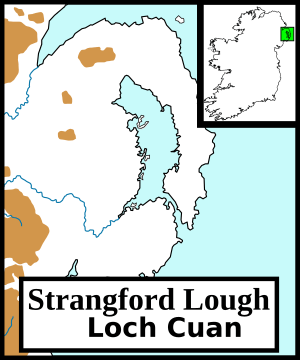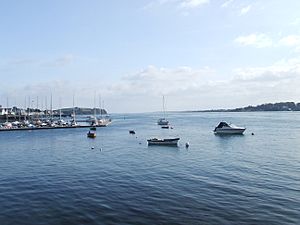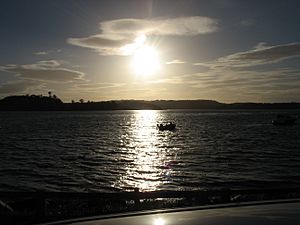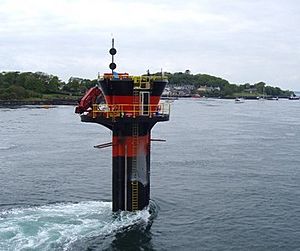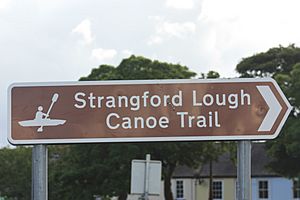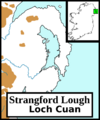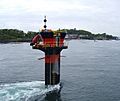Strangford Lough facts for kids
Strangford Lough is a very large sea inlet or "loch" located in County Down, in the east of Northern Ireland. It is the biggest sea inlet in the British Isles, covering about 150 square kilometers (58 square miles).
The Ards Peninsula almost completely surrounds the lough. It connects to the Irish Sea through a long, narrow channel on its southeastern side. The main part of Strangford Lough has at least seventy islands, plus many smaller islets, bays, and mudflats.
Strangford Lough is very important for nature. It was named Northern Ireland's first Marine Conservation Zone in 2013. It is also a Special Area of Conservation because of its amazing wildlife. Many different animals and plants live here, making it a special place around the world.
Long ago, in the Middle Ages, people in Ireland called it Loch Cuan. This name means "sea-inlet of bays or safe places."
Strangford Lough is a popular spot for visitors. People enjoy fishing and looking at the beautiful scenery. Towns and villages around the lough include Killyleagh, Comber, Newtownards, Portaferry, and Strangford. The towns of Portaferry and Strangford are on opposite sides of the narrow channel. A special car ferry connects them, making it easy to cross.
Contents
What's in a Name?
The name Strangford comes from an old Viking language called Old Norse. It means "strong sea-inlet." The Vikings were active in this area many centuries ago. At first, this name only referred to the narrow channel that links the lough to the sea. This channel is between the villages of Strangford and Portaferry.
Before the 1700s, the main part of the lough was known by its older Irish name, Loch Cuan. This means "loch of the bays or safe places." This Irish name was sometimes spelled in English as Lough Coan or Lough Cone. In Ulster-Scots, the lough's name is spelled Strangfurd or Strangfirt Loch.
How Strangford Lough Was Formed
Strangford Lough was created at the end of the last ice age. Most of the lough is less than 10 meters (33 feet) deep. However, in some parts, especially in the center channel, it can be much deeper, reaching 50 to 60 meters (164 to 197 feet) deep.
Amazing Plants of the Lough
Strangford Lough is home to many interesting plants, especially seaweeds and other water plants.
Flowering Plants
A type of grass called common cord-grass (Spartina anglica) was brought here in the 1940s. It has now grown a lot and is very common around the lough.
Algae and Seaweeds
Maerl is a special type of calcium-rich algae. It forms beds of branched, coral-like plants that can be living or dead. Two main types of maerl grow in Strangford Lough: Phymatolithon calcareum and Lithothamnion glaciale.
The rocky shores in the south of the lough have a lot of knotted wrack (Ascophyllum nodosum). Different types of seaweed grow in specific zones on these shores. For example, channel wrack grows highest, followed by spiral wrack, then knotted wrack, and finally serrated wrack closer to the low water mark.
An interesting brown seaweed called Sargassum muticum was found in the lough in 1995. This seaweed originally came from the Pacific (Japan). It was found growing on bags that held oysters imported from Guernsey. This type of Sargassum is known to spread very quickly and can take over areas.
Wildlife of Strangford Lough
Strangford Lough is a very important place for birds and other animals. It is known as an Important Bird Area.
Birds and Seals
Strangford Lough is a key winter home for many birds that migrate. These include wading birds and sea birds. Common seals are often seen in the lough. You might also spot basking sharks, which are large, gentle sharks.
One of the most special visitors is the pale-bellied brent goose. About three-quarters of the world's population of these geese spend their winter here! Sometimes, as many as 15,000 brent geese can be found in the lough area.
Other Animals
In 2012, an invasive animal called the carpet sea squirt (Didemnum vexillum) was found in the lough. This creature can spread quickly and affect the local environment.
Making Electricity from Tides
In 2007, Strangford Lough became home to the world's first commercial tidal stream power station, called SeaGen. This underwater generator used the fast tidal currents in the lough to make electricity. The water can flow as fast as 4 meters (13 feet) per second here!
SeaGen was powerful enough to provide electricity for up to a thousand homes. Even though it was powerful, it had very little impact on the environment. It was almost completely underwater, and its blades turned slowly. This meant they were not a danger to wildlife.
Another tidal energy device, called Evopod, was tested in the lough in 2008. This was a smaller, 1/10 scale model. It was a floating turbine that was partly submerged and anchored to the seabed. It was tested near the Portaferry Ferry landing.
Sports and Activities
Strangford Lough is a great place for sports, especially rowing. In July 2016, the lough hosted a big international rowing competition called “Skiffie Worlds 2016.” Rowing clubs from many countries, including Scotland, England, the Netherlands, the United States, Canada, and Tasmania, took part. The races were held over a 2-kilometer (1.2-mile) course at Delamont Country Park.
The Strangford Ferry
The Portaferry–Strangford ferry service has been running for almost 400 years! It connects the villages of Portaferry and Strangford, which are at the mouth of the lough. Without the ferry, driving between these two places would take about an hour and a half, covering 47 miles (76 kilometers).
The ferry crosses the narrow strait in just 8 minutes. The strait is only about 0.6 nautical miles (1.1 kilometers) wide. This public service carries both people and vehicles. Even though it costs money to run, it is seen as a very important way to travel to the Ards Peninsula.
History Under the Water
Strangford Lough has a rich history hidden beneath its waters and along its shores. Recent surveys have found hundreds of old sites. These include ancient fish traps, tidal mills (mills powered by the tides), old walls for gathering kelp, and places where boats used to land.
Images for kids
See also
 In Spanish: Strangford Lough para niños
In Spanish: Strangford Lough para niños



